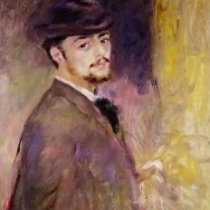 1849 - 1910
impressionism
1849 - 1910
impressionism
Description Antonietta Brandeis
Antonietta Brandeis, an artist often obscured in the shadows of her contemporaries, emerges as a captivating figure in the tapestry of art history. Born in Miskowitz, Bohemia, Brandeis defied societal expectations by pursuing an artistic career in an era resistant to women in the arts.
Her journey led her to the cultural hubs of Munich and Venice, where she honed her skills. Brandeis's work, often overlooked in discussions of 19th-century art, reveals a profound connection to the picturesque landscapes of Venice. Her paintings, such as "The Grand Canal" and "View of the Doge's Palace," capture the city's luminosity and vibrant atmosphere with a nuanced touch.
Brandeis's unique artistic voice emerged in her adept fusion of realism and impressionism. Her palette, awash with the Venetian light, reflected an affinity for the fleeting nuances of the city's canals and architecture. Despite societal constraints on women artists, Brandeis carved a space for herself, contributing to the flourishing cultural milieu of her time.
While she navigated the male-dominated art world, her works found recognition in exhibitions across Europe. The delicacy of her brushstrokes and the evocative charm of her scenes, reminiscent of the Venetian School, garnered praise.
Beyond her canvases, Brandeis's life mirrored the cultural crossroads of her time. Her artistic pursuits coincided with a period of profound change in art, marked by the rise of new movements and a shifting appreciation for diverse styles.
Antonietta Brandeis's legacy, though somewhat obscured, is a testament to resilience and artistic passion. Her contribution to the rich visual narrative of Venice stands as an understated yet significant chapter in the broader story of art. In the quiet elegance of her paintings, we glimpse not only the Venetian vistas but also the enduring spirit of a woman who defied conventions to paint her own path in the colorful mosaic of art history.



























No Comments Yet...